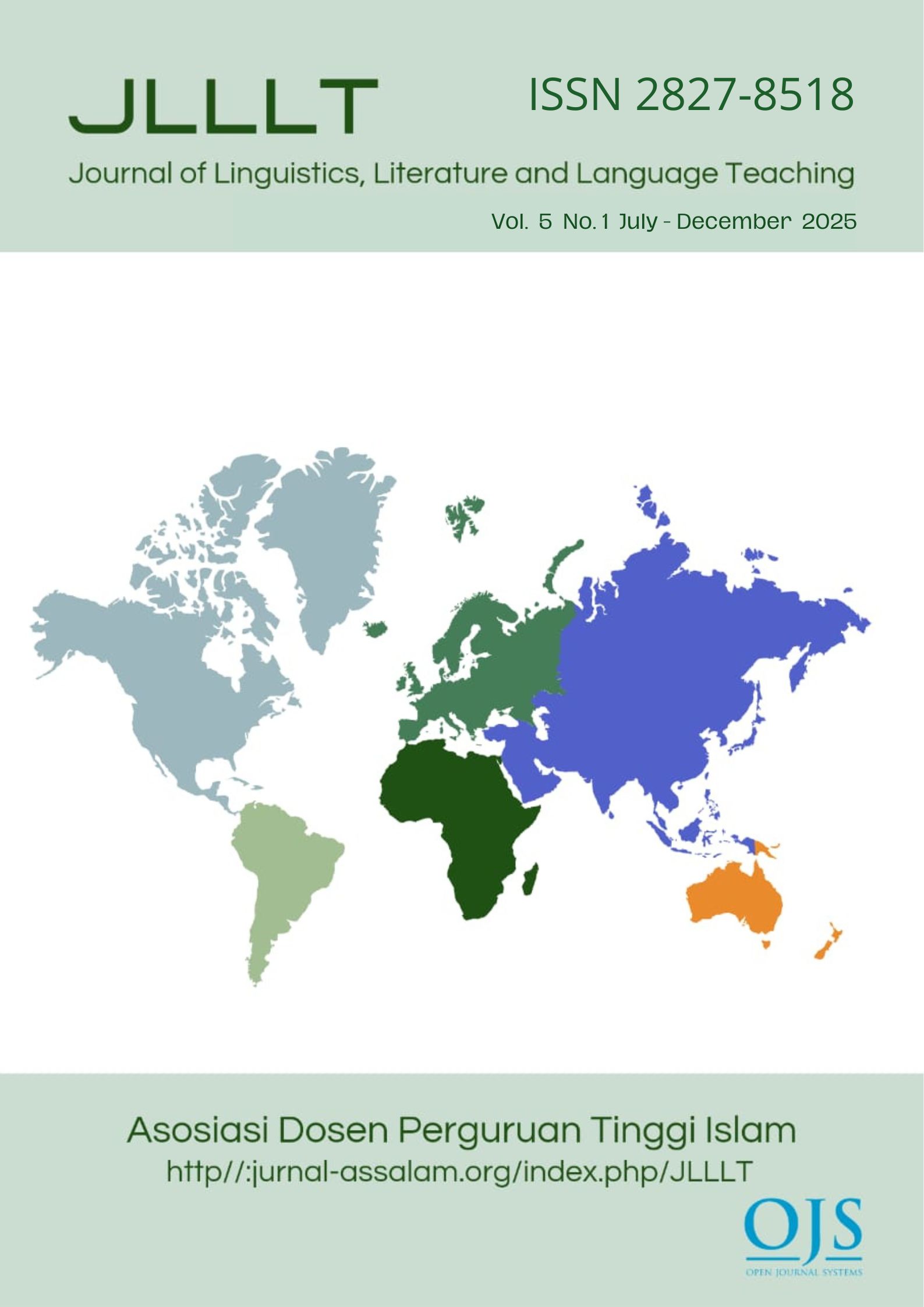Semantic Urgency and Illusion of Authority in Phishing Emails: A Corpus-Based Analysis
DOI:
https://doi.org/10.37249/jlllt.v5i1.908Kata Kunci:
Phishing Discourse, Semantics Frame, fillmore, CorpusAbstrak
This study examines how urgency and authority are semantically framed in phishing emails to manipulate recipients’ behavior. Although linguistic features of deception have been widely studied, the semantic framing of phishing remains underexplored within the Frame Semantics framework. Using qualitative frame-semantic discourse analysis, ten phishing emails were purposively selected from the open-access corpus by Miltchev et al. (2024), focusing on scams related to account access and payment issues. The data were analyzed through Fillmore’s Frame Semantics to identify lexical units and frame elements (e.g., Agent, Goal, Instrument) that trigger urgency and authority. Results show that phishing messages use time-sensitive cues (e.g., immediately, within 24 hours) and institutional references (e.g., your account, verify your identity) to create a sense of crisis and compel compliance. These frames often co-occur, increasing cognitive pressure and reducing critical evaluation. By mapping manipulative strategies onto semantic frames such as Request, Threat scenario, and Commerce transfer, this study provides a structured approach to phishing analysis. It contributes to cyber linguistics and supports the development of frame-aware digital literacy, email security systems, and spam detection models based on semantic cues.
Unduhan
Referensi
Alkhalil, Z., Hewage, C. T. E. R., Nawaf, L., & Khan, I. A. (2021). Phishing attacks: A recent comprehensive study and a new anatomy. Frontiers of Computer Science, 3, 563060. https://doi.org/10.3389/FCOMP.2021.563060
Altmann, E. M., Trafton, J. G., & Hambrick, D. Z. (2017). The effects of deadlines on task performance: Evidence for a cognitive resource limitation. Journal of Experimental Psychology: General, 146(3), 457–472. https://doi.org/10.1037/xge0000268
Baker, C. F. (2017). FrameNet: Frame semantic annotation in practice. In Advances in Frame Semantics: Theory and Practice (pp. 771–811). Springer, Dordrecht. https://doi.org/10.1007/978-94-024-0881-2_28
Baryshevtsev, M., & McGlynn, T. (2020). Persuasive appeals predict credibility judgments of phishing messages. Cyberpsychology, Behavior, and Social Networking, 23(5), 297–302. https://doi.org/10.1089/CYBER.2019.0592
Chrysanthou, Pantis, Y, Patsakis. (2024). The anatomy of deception: Measuring technical and human factors of a large-scale phishing campaign. Computers & Security, 140, 103780. https://doi.org/10.1016/j.cose.2024.103780
Décosse, Molnar, Proper. (2013). A Qualitative Research Approach to Obtain Insight in Business Process Modelling Methods in Practice. In The Practice of Enterprise Modelling (pp. 161–175). Springer, Dordrecht. https://doi.org/10.1007/978-3-642-41641-5_12
Elbardan, H., & Rashwan Kholeif, A. O. (2017). An Interpretive Approach for Data Collection and Analysis. Cham: Palgrave Macmillan, Cham. https://doi.org/10.1007/978-3-319-54990-3_5
Fillmore, C. J. (1982). Frame semantics. In Linguistics in the Morning Calm (pp. 111–137). Seoul: Hanshin Publishing Co.
Forte, D. (2009). Phishing Attacks: Phishing in depth. Network Security Archive, 5, 19–20. https://doi.org/10.1016/S1353-4858(09)70055-8
Guo, Z., Wang, P., Cho, J.-H., Huang, L. (2023). Text mining-based social-psychological vulnerability analysis of potential victims to cybergrooming: Insights and lessons learned. Companion Proceedings of the ACM Web Conference 2023, 1381–1388. https://doi.org/10.1145/3543873.3587303
Jones, C. L., Somerville, L. H., Li, J., Ruberry, E. J., & Delgado, M. R. (2011). Under pressure: Response urgency modulates striatal and insula activity during decision-making under risk. PLoS ONE, 6(6), Article e20942. https://doi.org/10.1371/JOURNAL.PONE.0020942
Joullié, J. E., Gould, A. M., Spillane, R., & Luc, S. (2021). The language of power and authority in leadership. Leadership Quarterly, 32(4), 101491. https://doi.org/10.1016/j.leaqua.2020.101491
Miltchev, R, Rangelov, D, Genchev, E. (2024). Phishing validation emails dataset (Version 1) [Data set]. https://doi.org/10.5281/zenodo.13474746
Narayanan, S., Fillmore, C. J., Baker, C. F., Petruck, M. R. L. (2002). FrameNet meets the Semantic Web: A DAML+OIL frame representation. Proceedings of the 18th National Conference on Artificial Intelligence (AAAI). https://aaai.org/papers/ws02-16-005-framenet-meets-the-semantic-web-a-damloil-representation-of-framenet/
Nurdin, N., & Pettalongi, S. S. I. (2022). An interpretive case study to understand online communication in an e-tendering project implementation. Jurnal Manajemen Komunikasi, 7(1), 39. https://doi.org/10.24198/jmk.v7i1.39715
Orman, H. (2012). Towards a semantics of phish. IEEE Symposium on Security and Privacy, 91–96. https://doi.org/10.1109/SPW.2012.12
Searle, J. R. (1979). Expression and meaning: Studies in the theory of speech acts. Cambridge: Cambridge University Press.
Searle, J. R. (1994). Structure and Intention in Language: A Reply to Knapp and Michaels. New Literary History, 25(3), 677–692. https://doi.org/10.2307/469472
Shafqat, W., Lee, S., Malik, S., Kim, H.-C. (2016). The language of deceivers: Linguistic features of crowdfunding scams. Proceedings of the 25th International Conference Companion on World Wide Web (WWW ’16 Companion), 145–150. https://doi.org/10.1145/2872518.2889356
Sweller, J. (2011). Cognitive load theory. In B. H. Mestre, J. P.; Ross (Ed.), The psychology of learning and motivation: Cognition in education (pp. 37–76). Elsevier Academic Press. https://doi.org/10.1016/B978-0-12-387691-1.00002-8
Tian, C. A., Jensen, M. L., & Bott, R. (2024). The influence of affective processing on phishing susceptibility. European Journal of Information Systems. Journal of Information Systems, 34(3), 460–474. https://doi.org/10.1080/0960085X.2024.2351442
Tyler, T. R., & Jackson, J. (2014). Popular legitimacy and the exercise of legal authority: motivating compliance, cooperation and engagement. Psychology, Public Policy and Law, 20(1), 78–95. https://doi.org/10.1037/A0034514
Varekamp, I. (2014). Analyseren bij descriptief onderzoek: Ordenen, samenvatten, vergelijken, interpreteren. KWALON, 19(3). https://doi.org/10.5117/2014.019.003.079
Wright, A., Hickman, T. T., McCoy, A. B., & Gadd, C. S. (2016). The Big Phish: Cyberattacks Against U.S. Healthcare Systems. Journal of General Internal Medicine, 31(10), 1115–1118. https://doi.org/10.1007/S11606-016-3741-Z
Zhu, M., Yang, Y., & Hsee, C. K. (2018). The Mere Urgency Effect. Journal of Consumer Research, 45(3), 673–690. https://doi.org/https://www.jstor.org/stable/27030212
Unduhan
Diterbitkan
Cara Mengutip
Terbitan
Bagian
Lisensi
Hak Cipta (c) 2025 Rossy Halimatun Rosyidah

Artikel ini berlisensiCreative Commons Attribution-ShareAlike 4.0 International License.





.png)














